It looks like you're using an Ad Blocker.
Please white-list or disable AboveTopSecret.com in your ad-blocking tool.
Thank you.
Some features of ATS will be disabled while you continue to use an ad-blocker.
share:
So I was watching this BBC documentary the other day, entitled "Can Eating Insects Save the World?".
Basically, Insects are much less resource intensive to farm than other types of meat, cows in particular require a huge amount of grain and water to take care of, far more than insects, which actually provide far more nutritional value pound for pound than beef.
Here's the video, it's quite well done-
Personally, every time I'm in the LA area, I like to stop by this Asian Fusion restaurant that's called 'Typhoon', and I'll get the Taiwanese Crickets and also the Silk-worm Larvae, they're both super tasty and well prepared, and fairly cheap. Haven't tried the scorpions yet, but I will next time.
www.typhoon.biz...


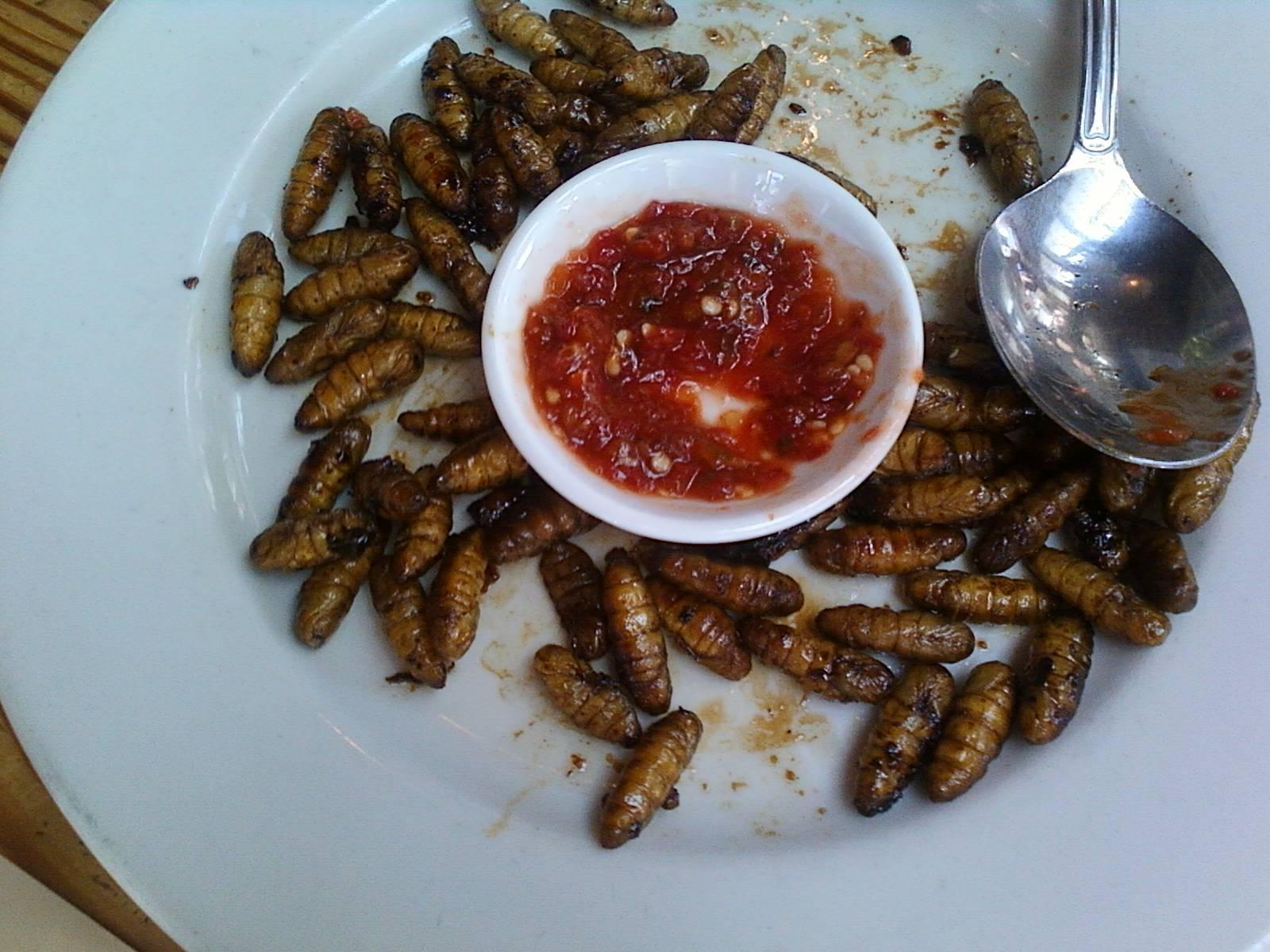
Really hope I could make it out to Thailand one day so I could sample some of the more exotic insect dishes-
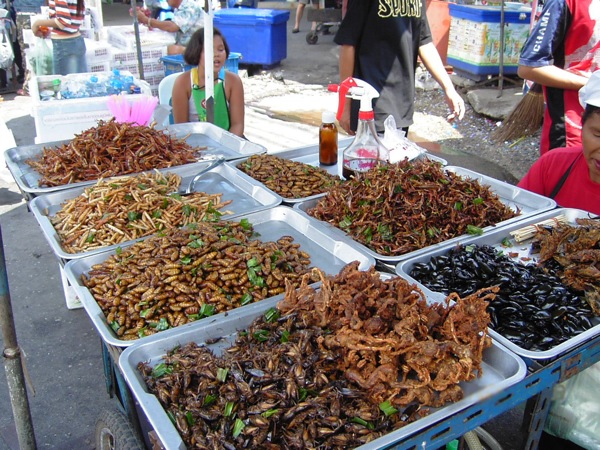




They even eat tarantulas in some areas!
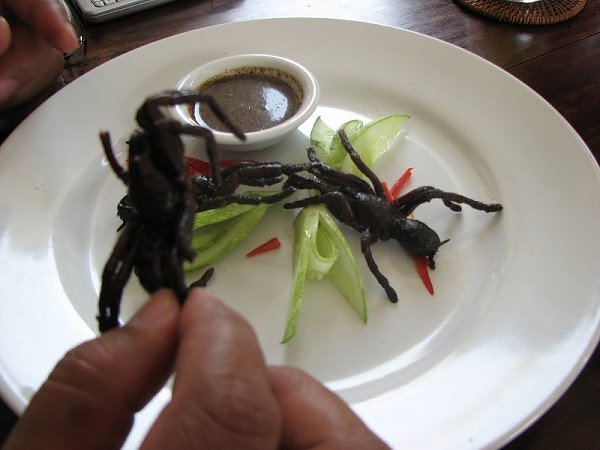
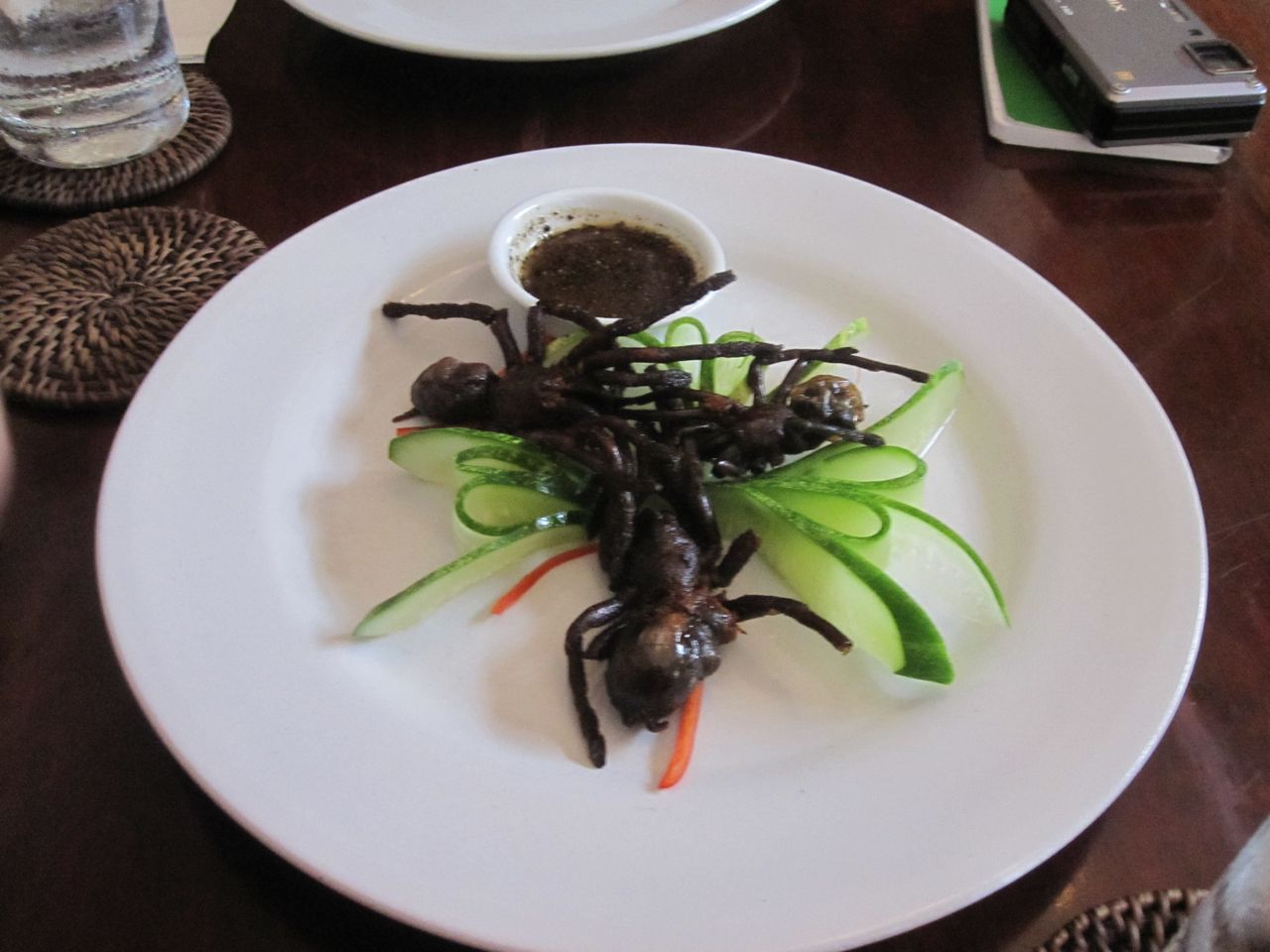
Nomnomnom!
I've actually been thinking about starting a cricket farm and growing my own supply.
So how about it ATS? Ever eaten insects? Do you find the concept revolting? Would you give it a try?
How would you feel about eating deep fried locusts, ant egg salad or barbequed tarantulas? This documentary sees presenter and food writer Stefan Gates immerse himself in the extraordinary world of hardcore insect-eating in a bid to conquer his lingering revulsion of bugs and discover if they really could save the planet. With 40 tonnes of insects to every human, perhaps insects could offer a real solution to the global food crisis - where billions go hungry every day whilst the meat consumption of the rich draws vast amounts of grain out of the global food chain.
Basically, Insects are much less resource intensive to farm than other types of meat, cows in particular require a huge amount of grain and water to take care of, far more than insects, which actually provide far more nutritional value pound for pound than beef.
The benefits of consuming insects are multifold, starting with the fact that they're good for you. Consider the following: 100 grams of crickets contains 121 calories. Only 49.5 calories come from fat. Where you really see the nutritional value is in the 12.9 grams of protein and 75.8 milligrams of iron. They also have about 5 grams of carbohydrates. If you're watching your figure and want to cut down on the carbs, go with a silk worm pupae or a nice steaming bowl of termites. Neither of these has any carbohydrates, and they're both great sources of protein and calories. But if it's protein you seek, look no further than the caterpillar. These little fellows pack a walloping 28 grams of protein per 100 grams [source: Lyon]. They're also loaded with iron, thiamine and niacin. You may know those last two by their more common names -- vitamins B1 and B3.
Compare the nutritional value of insects to beef and even fish and it's pretty clear which one is the smart food. While having protein levels on par with caterpillars, lean ground beef and cod come up short in iron and vitamin levels. Crickets also contain a lot of calcium, which we know is good for bone development. Besides nutritional value, insects are also abundant and environmentally sustainable. Farming and harvesting insects takes very little water and transport fuel compared to livestock, grains and even vegetables. It's also more efficient than raising cattle. One hundred pounds of feed produces 10 pounds of beef. The same amount of feed would produce more than four times that amount in crickets [source: National Geographic]. If America and Europe got on board, insects could help to provide a sustainable food source for the future.
Here's the video, it's quite well done-
Personally, every time I'm in the LA area, I like to stop by this Asian Fusion restaurant that's called 'Typhoon', and I'll get the Taiwanese Crickets and also the Silk-worm Larvae, they're both super tasty and well prepared, and fairly cheap. Haven't tried the scorpions yet, but I will next time.
www.typhoon.biz...



Really hope I could make it out to Thailand one day so I could sample some of the more exotic insect dishes-





They even eat tarantulas in some areas!


Nomnomnom!
I've actually been thinking about starting a cricket farm and growing my own supply.
So how about it ATS? Ever eaten insects? Do you find the concept revolting? Would you give it a try?
reply to post by ExquisitExamplE
I find the concept a good one overall, but have been so conditioned against insects I don't think this would work for me. Insects in large bunches freak me out dead or alive; I deal okay with one or two but more than three and I get anxious. I have to say thinking about eating them leaves me revolted, unfortunately.
I find the concept a good one overall, but have been so conditioned against insects I don't think this would work for me. Insects in large bunches freak me out dead or alive; I deal okay with one or two but more than three and I get anxious. I have to say thinking about eating them leaves me revolted, unfortunately.
I think it's a great idea to try. For those grossed out by texture/appearance like Ameilia above me perhaps we could make some sort of patties or
something without all the legs. I have no idea what the little buggers taste like, but I assume enough rooster sauce will drown out any nastiness. A
cheap easily renewable source of protein with less environmental impact sounds good to me.
There are two kinds of meat I never want to eat. Human and dog. I'm not sure which would bother me more. I'll nom some insect.
There are two kinds of meat I never want to eat. Human and dog. I'm not sure which would bother me more. I'll nom some insect.
Definitely a Doc I would like to watch soon.
I myself have dabbled in edible insects and the awkwardness dissipates fairly quickly as long as you enjoy the flavor. Really not that much different than trying sushi for the first time. I would love to be a insectivore/invasivore, but I feel it would be difficult to acquire food regularly.
I own lots of exotic pets including reptiles scorpions and tarantulas and feed them a variety of insects. I raised some super worms (meal worms) on oats and carrots and decided to try them. I settled on a fairly common stir fry method and used coconut oil, green onions, onion, garlic, a little ginger, and a few other things I cant remember.
The super worms themselves just cooked in coconut oil after being raised on the oats and carrots had a very familiar flavor. It was somewhere between a nutty flavor and crispy chicken skin. YUMMY!
www.youtube.com...
I myself have dabbled in edible insects and the awkwardness dissipates fairly quickly as long as you enjoy the flavor. Really not that much different than trying sushi for the first time. I would love to be a insectivore/invasivore, but I feel it would be difficult to acquire food regularly.
I own lots of exotic pets including reptiles scorpions and tarantulas and feed them a variety of insects. I raised some super worms (meal worms) on oats and carrots and decided to try them. I settled on a fairly common stir fry method and used coconut oil, green onions, onion, garlic, a little ginger, and a few other things I cant remember.
The super worms themselves just cooked in coconut oil after being raised on the oats and carrots had a very familiar flavor. It was somewhere between a nutty flavor and crispy chicken skin. YUMMY!
www.youtube.com...
edit on 8/11/13 by 404ed because: (no reason given)
reply to post by Ameilia
Yeah, I can definitely see how some people could be squeamish about it; like you said, so many kids in western nations have been conditioned to think that bugs are gross or scary, whereas kids in southeast Asia just see lunch! You just have to step outside your comfort zone a bit and it's all mind over matter after that. Do you like shrimp and lobster? Those are basically just aquatic insects...
reply to post by Domo1
The taste really depends on what kind you're eating; crickets are so small that they tend to take on the flavor of whatever they're cooked in, usually aromatics like herbs and chiles with a splash of soy sauce. Silkworm pupa have a very unique and interesting flavor that's nutty and earthy. My experience is actually pretty limited, I definitely want to try grasshoppers and tarantulas, and also giant water bugs.
And yes, put enough Sriracha on anything and it will overwhelm the palate, but then you'd be missing out on all the buggy goodness!
Although it does remind me of a comic I saw once-
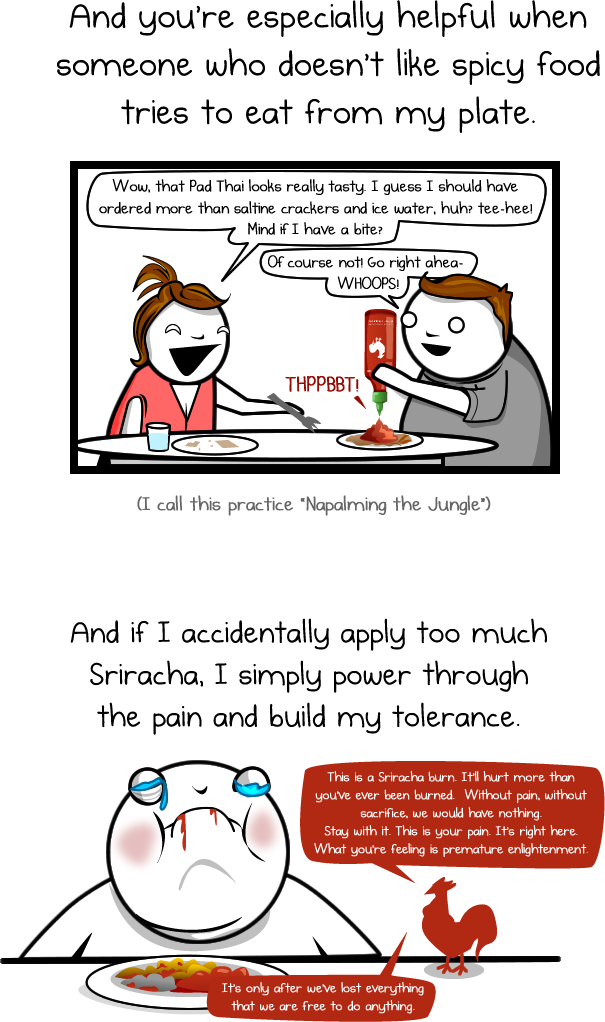
Yeah, I can definitely see how some people could be squeamish about it; like you said, so many kids in western nations have been conditioned to think that bugs are gross or scary, whereas kids in southeast Asia just see lunch! You just have to step outside your comfort zone a bit and it's all mind over matter after that. Do you like shrimp and lobster? Those are basically just aquatic insects...
reply to post by Domo1
The taste really depends on what kind you're eating; crickets are so small that they tend to take on the flavor of whatever they're cooked in, usually aromatics like herbs and chiles with a splash of soy sauce. Silkworm pupa have a very unique and interesting flavor that's nutty and earthy. My experience is actually pretty limited, I definitely want to try grasshoppers and tarantulas, and also giant water bugs.
And yes, put enough Sriracha on anything and it will overwhelm the palate, but then you'd be missing out on all the buggy goodness!
Although it does remind me of a comic I saw once-

reply to post by 404ed
You should definitely check it out, it's really informative and you get to see some beautiful people and their country.
If you want to get technical about it, the term for insect eating by humans is entomophagy, whereas the term insectivore refers to only non-human animals.
en.wikipedia.org...
If you watch the documentary, at about 43 minutes in, he goes to a cricket farm where they are raising crickets by the thousands; this is the type of operation I'd like to set-up, but on a smaller scale of course. I'm fairly certain that I could set up something like that for quite cheap, and, as you mentioned, there are plenty of places where you can order insects online for reptile feeding purposes.
You should definitely check it out, it's really informative and you get to see some beautiful people and their country.
If you want to get technical about it, the term for insect eating by humans is entomophagy, whereas the term insectivore refers to only non-human animals.
en.wikipedia.org...
If you watch the documentary, at about 43 minutes in, he goes to a cricket farm where they are raising crickets by the thousands; this is the type of operation I'd like to set-up, but on a smaller scale of course. I'm fairly certain that I could set up something like that for quite cheap, and, as you mentioned, there are plenty of places where you can order insects online for reptile feeding purposes.
I don't mind ants. Choc coated bull ants are great. Really tangy!
But as for all the ones that go squish when you step on them ..... no Thanks!
Deep fried Roach. What about the yellow insides that look like puss.
Not for me .... no thanks ...... not at all!
P
But as for all the ones that go squish when you step on them ..... no Thanks!
Deep fried Roach. What about the yellow insides that look like puss.
Not for me .... no thanks ...... not at all!
P
Actually eating bugs and critters while in Thailand made me realize that most things have the same taste that all can relate too.
Ever hear crabs and lobsters are the spiders of the sea? The truth being, they really do taste alike. Land spiders taste remarkably like crab (unless cooked all funky like). Scorpids almost the same.
Grubs and meal worms, when toasted and seasoned right, taste just like boiled peanuts. The perfect beer snack. You have to had eaten boiled peanuts first so you can get used to the texture...grubs are very 'soft' in texture.
The others, rice bugs, grasshoppers, etc., have their own taste. They can have starchy flavors. Seasoned properly, they are very yummy. Grasshoppers can have a curly fries taste going on.
But I have noticed - anything deep fried tastes good. If you can't stomach bug eating, try 'em deep fried with seasonings. That is how I got past most of the bug eating.
They can be costly too. In Thailand, bugs are almost a delicacy.
Ever hear crabs and lobsters are the spiders of the sea? The truth being, they really do taste alike. Land spiders taste remarkably like crab (unless cooked all funky like). Scorpids almost the same.
Grubs and meal worms, when toasted and seasoned right, taste just like boiled peanuts. The perfect beer snack. You have to had eaten boiled peanuts first so you can get used to the texture...grubs are very 'soft' in texture.
The others, rice bugs, grasshoppers, etc., have their own taste. They can have starchy flavors. Seasoned properly, they are very yummy. Grasshoppers can have a curly fries taste going on.
But I have noticed - anything deep fried tastes good. If you can't stomach bug eating, try 'em deep fried with seasonings. That is how I got past most of the bug eating.
They can be costly too. In Thailand, bugs are almost a delicacy.
Originally posted by pheonix358But as for all the ones that go squish when you step on them ..... no Thanks!
Ants go squish when you step on them, it's just a little squish. You know, a chicken will go squish if you step on it too...
Originally posted by pheonix358
What about the yellow insides that look like puss.
They're chock full of nutrients?
reply to post by ChuckNasty
Indeed. Insects come in all types of shapes, sizes, and flavors. Also, what you're saying about bugs being pricey in Thailand is definitely true, in fact, there's a part in the documentary where he goes to a little village in Cambodia where all the villagers go out in the night and harvest grasshoppers. They put them into little netted bags and then the next day, a buyer from Thailand comes and buys the lot of them. I know that those giant water bugs in particular can fetch top dollar.
reply to post by ExquisitExamplE
Thank you for the correction.
I personally haven't done any research on that type of life style. Obviously getting a hold of insects and breeding them is no problem, but the invasivore side of the coin would be a little more difficult. Unless there is a business that hunts invasive species and sells them you would constantly have to go out of your way to acquire them. If it was feasible then it would be a great way to help with pest control.
I have actually thought about raising feeder insects to sell locally for some money on the side but haven't done the research nor do I have the space yet. We will se what the future holds.
Thank you for the correction.
I personally haven't done any research on that type of life style. Obviously getting a hold of insects and breeding them is no problem, but the invasivore side of the coin would be a little more difficult. Unless there is a business that hunts invasive species and sells them you would constantly have to go out of your way to acquire them. If it was feasible then it would be a great way to help with pest control.
I have actually thought about raising feeder insects to sell locally for some money on the side but haven't done the research nor do I have the space yet. We will se what the future holds.
reply to post by ExquisitExamplE
Siracha makes everything a tasty firestorm!
As for bugs, I suppose its all in how its prepare I mean cook they kinda looked good and I'm sure anything deep fried is tasty. Theres always garlic too, spice it up. I rather have to eat bugs than guts.
Siracha makes everything a tasty firestorm!
As for bugs, I suppose its all in how its prepare I mean cook they kinda looked good and I'm sure anything deep fried is tasty. Theres always garlic too, spice it up. I rather have to eat bugs than guts.
wood ant eggs are very nice and mealworms are quite nutty, but locusts deep fried in peanut oil are just wonderful
reply to post by ExquisitExamplE
Author Robert Anton Wilson said that only one out of a thousand humans know that insects are people. Eating one of them is like eating your neighbor (remember "Love your neighbor as yourself"?). Just a couple days ago I was looking at a beetle who was climbing a post near me, and I noticed that his/her back legs were very strong, and that it had four arms instead of two. I thought of Wilson's quote while looking at this little fellow/gal.
Author Robert Anton Wilson said that only one out of a thousand humans know that insects are people. Eating one of them is like eating your neighbor (remember "Love your neighbor as yourself"?). Just a couple days ago I was looking at a beetle who was climbing a post near me, and I noticed that his/her back legs were very strong, and that it had four arms instead of two. I thought of Wilson's quote while looking at this little fellow/gal.
I would certainly eat them before starving, but not my first choice. I do appreciate the shock value of the roasted crickets I often get at theme
parks though. They aren't bad, really.
The idea of making them more into "meat" patties for consumption is a good one, I think, and could certainly go a long way to feeding the hungry. I guess the real question is cost of production. If economically feasible (and I can't see how it wouldn't be, with the breeding rate of insects), it could certainly be PART of the solution at least.
The idea of making them more into "meat" patties for consumption is a good one, I think, and could certainly go a long way to feeding the hungry. I guess the real question is cost of production. If economically feasible (and I can't see how it wouldn't be, with the breeding rate of insects), it could certainly be PART of the solution at least.
Haven't tried any of them, but would def try any of em without question, I like to try different things, and eating insects would be different for
me... yep.. makes me want some now.... ok gotta goooo just seen a spider go into my greenhouse...come back here you delicious little bugger.....
reply to post by 404ed
Thank you for bringing up the term Invasivore, it led me down a line of discovery and research heretofore unbeknownst to me. Really fascinating stuff and definitely a practice that we as a society should be exploring much more ardently... When god gives you locusts, make locust kebabs, all the while shaking your fist at the sky, screaming "IS THAT ALL YOU GOT YOU OLD BASTARD?!".
reply to post by Aleister
Strictly speaking, insects are not people as they do not share our vibrational density level and aptitude for individualized self-awareness. That said, it doesn't mean that they are not fellow beings deserving of love and respect. While I may use them as food, I will always thank them for my sacrifice of them, and I would hope that when I die, they find me a tasty and hopefully not too stringy morsel on which to sup.
reply to post by Gazrok
That must be a pretty wild theme-park that serves crickets as snacks, I've never heard of such a thing!
Also, while it may make it more palatable for the squeamish to turn them into patties, you'd be losing out on a lot of the inherent texture and absorbability that insects naturally have; all those little crevices make for great areas to soak up sauces and spices, they're like mini flavor sponges!
reply to post by flipflop
That's the spirit! Just make sure your neighbors don't see you running around putting spiders in your mouth, they're liable to call social services and have you committed, and once you're in the loony bin, it becomes increasingly difficult to find tasty bugs to munch!
Thank you for bringing up the term Invasivore, it led me down a line of discovery and research heretofore unbeknownst to me. Really fascinating stuff and definitely a practice that we as a society should be exploring much more ardently... When god gives you locusts, make locust kebabs, all the while shaking your fist at the sky, screaming "IS THAT ALL YOU GOT YOU OLD BASTARD?!".
reply to post by Aleister
Strictly speaking, insects are not people as they do not share our vibrational density level and aptitude for individualized self-awareness. That said, it doesn't mean that they are not fellow beings deserving of love and respect. While I may use them as food, I will always thank them for my sacrifice of them, and I would hope that when I die, they find me a tasty and hopefully not too stringy morsel on which to sup.
reply to post by Gazrok
That must be a pretty wild theme-park that serves crickets as snacks, I've never heard of such a thing!
Also, while it may make it more palatable for the squeamish to turn them into patties, you'd be losing out on a lot of the inherent texture and absorbability that insects naturally have; all those little crevices make for great areas to soak up sauces and spices, they're like mini flavor sponges!
reply to post by flipflop
That's the spirit! Just make sure your neighbors don't see you running around putting spiders in your mouth, they're liable to call social services and have you committed, and once you're in the loony bin, it becomes increasingly difficult to find tasty bugs to munch!
new topics
-
Australian mercenary caught and crying as he is a prisoner of war.
Other Current Events: 5 hours ago -
JILL BIDEN Wants JOE to Punish Democrats Who Forced Him to Leave Office in Disgrace on 1.20.2025.
2024 Elections: 5 hours ago -
Panamanian President-“every square meter” of the Panama Canal belongs to Panama.
New World Order: 6 hours ago -
NYPD arrests migrant who allegedly set woman on fire on subway train, watched her burn to death
Breaking Alternative News: 8 hours ago -
Chef Gerald R. Ford
Food and Cooking: 11 hours ago -
The clotting is not going away latest
Medical Issues & Conspiracies: 11 hours ago
top topics
-
California Business Owners Blindsided by Surprise Payroll Taxes
US Political Madness: 13 hours ago, 20 flags -
The clotting is not going away latest
Medical Issues & Conspiracies: 11 hours ago, 10 flags -
F-18 shot down over Red Sea....by our own Destroyer?
Other Current Events: 13 hours ago, 7 flags -
NYPD arrests migrant who allegedly set woman on fire on subway train, watched her burn to death
Breaking Alternative News: 8 hours ago, 6 flags -
Panamanian President-“every square meter” of the Panama Canal belongs to Panama.
New World Order: 6 hours ago, 6 flags -
Australian mercenary caught and crying as he is a prisoner of war.
Other Current Events: 5 hours ago, 6 flags -
JILL BIDEN Wants JOE to Punish Democrats Who Forced Him to Leave Office in Disgrace on 1.20.2025.
2024 Elections: 5 hours ago, 5 flags -
Chef Gerald R. Ford
Food and Cooking: 11 hours ago, 2 flags
active topics
-
‘Something horrible’: Somerset pit reveals bronze age cannibalism
Ancient & Lost Civilizations • 17 • : BrucellaOrchitis -
Australian mercenary caught and crying as he is a prisoner of war.
Other Current Events • 4 • : AdultMaleHumanUK -
Why isn't Psychiatry involved?
Social Issues and Civil Unrest • 30 • : BrucellaOrchitis -
The Daily Mail trying to imply “it’s aliens”
Dissecting Disinformation • 12 • : KrustyKrab -
The Effects of Electric Fields and Plasma on Plant Growth
Science & Technology • 8 • : ChaoticOrder -
Post A Funny (T&C Friendly) Pic Part IV: The LOL awakens!
General Chit Chat • 7945 • : KrustyKrab -
JILL BIDEN Wants JOE to Punish Democrats Who Forced Him to Leave Office in Disgrace on 1.20.2025.
2024 Elections • 5 • : KrustyKrab -
Panamanian President-“every square meter” of the Panama Canal belongs to Panama.
New World Order • 6 • : BeyondKnowledge3 -
Labour Plotting to Postpone May's Council Elections ?
Regional Politics • 13 • : angelchemuel -
Just spotted an unusual aircraft Melbourne Australia
Aliens and UFOs • 9 • : Cavemannick

